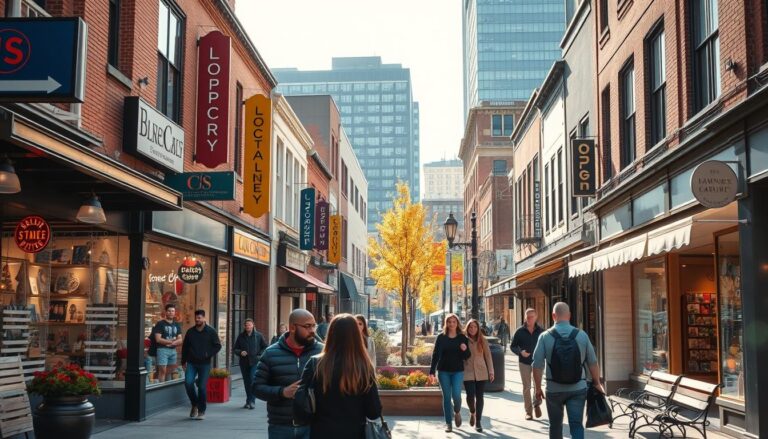Google handles over 105,000 searches every second, with nearly half seeking nearby solutions. For businesses, this creates urgent opportunities: 76% of mobile users visit stores within 24 hours of location-based searches. Missing from these results means losing customers to competitors down the street.
Success in local search requires more than basic optimization. Google’s algorithm prioritizes three elements: how close you are to searchers, how well your services match their needs, and your online reputation. Companies ranking high in these areas see 28% of local search visitors convert into buyers.
Strategic visibility improvements transform casual searches into foot traffic. Over 60% of smartphone users combine phrases like “best near me” with immediate needs, creating ready-to-buy audiences. Optimizing for these behaviors bridges the gap between digital discovery and real-world sales.
Key Takeaways
- 46% of searches target local goods/services, creating immediate revenue potential
- Mobile users convert faster: 3 in 4 visit stores within a day of searching
- Google prioritizes proximity, relevance, and prominence in local rankings
- Complete business profiles outperform competitors in map-based results
- Location-specific keywords drive 60% of mobile search conversions
Understanding the Fundamentals of Local SEO
Modern consumers increasingly blend digital searches with real-world actions. Over 60% of smartphone users now prioritize location-based queries like “open now” or “near me” when seeking immediate solutions. This behavioral shift makes specialized search strategies essential for connecting with ready-to-act audiences.
What Makes Local Search Optimization Unique?
Unlike traditional search engine optimization, local tactics focus on three core elements: proximity, relevance, and prominence. Businesses appearing in map-based results gain credibility through Google’s implied endorsement, while complete profiles attract 35% more clicks than incomplete listings.
| Factor | Traditional SEO | Local SEO |
|---|---|---|
| Primary Focus | Global/national visibility | Geographic targeting |
| Key Metrics | Organic rankings | Map pack appearances |
| Conversion Source | Website visits | Store visits/calls |
| Critical Components | Backlinks, content | Reviews, GBP accuracy |
Driving Decisions Through Location Signals
Mobile users conducting local searches convert 30% faster than desktop users. Businesses appearing in these search results benefit from what experts call “geographic urgency” – the combination of immediate need and physical accessibility. A well-optimized presence acts like digital word-of-mouth, with 68% of consumers trusting local listings more than generic ads.
Companies implementing targeted optimization strategies often see measurable revenue growth within 90 days. The connection between visibility and sales becomes clear when 78% of location-based mobile searches result in offline purchases.
Crafting a Winning go to market local SEO Strategy
Businesses dominating their neighborhoods start with precision targeting. Three elements separate leaders from competitors: hyper-relevant keyword selection, actionable competitor insights, and frictionless conversion paths.

Identifying Location-Specific Keywords for Success
Tools like Google Keyword Planner reveal what nearby customers actually search. Long-tail phrases like “emergency plumbing services Austin” outperform generic terms by 47% in conversion rates. Regional modifiers combined with service needs align with mobile users’ immediate intent.
Competitive Analysis and Market Trends
Reviewing rivals’ top-performing pages uncovers content gaps. Track which neighborhood mentions earn them map pack positions. Seasonal patterns matter too – restaurants near stadiums see 22% more “game day delivery” searches during sports seasons.
Strategies to Convert Traffic into Loyal Customers
Clear calls-to-action transform searchers into buyers. Service pages showing real-time availability get 31% more bookings. Testimonials with local landmarks (“Fixed my AC during Dallas heatwave”) build community trust better than generic reviews.
Consistent NAP (Name, Address, Phone) details across directories prevent 68% of lost opportunities from conflicting information. Mobile-optimized contact buttons reduce bounce rates by 19% compared to buried contact forms.
Optimizing Your Google Business Profile for Local Success
Your digital storefront needs more polish than a physical location. Google Business Profile optimization bridges the gap between being found and being chosen, with complete profiles receiving 2.7x more website clicks than incomplete listings.
Completing Your Profile Details Accurately
Mismatched phone numbers or outdated addresses cost businesses 42% of potential customers. Verify every detail matches your website and third-party directories. Update seasonal hours weekly – 73% of shoppers abandon profiles with incorrect operating times.
Strategic category selection boosts relevance. A bakery choosing “artisan bread shop” instead of “bakery” increases visibility for specialty searches by 19%. Attributes like “wheelchair accessible” or “curbside pickup” answer specific customer needs before they call.
Leveraging Reviews, Photos, and Attributes
Fresh images drive decisions – profiles with 10+ photos get 150% more direction requests. Showcase your team in action, popular products, and clean facilities. Respond to 90% of reviews within 48 hours using this framework:
- Thank reviewers by name
- Address specific concerns
- Highlight improvements made
Google Posts turn your profile into a communication channel. Share weekly specials or event announcements – businesses using this feature see 35% more profile interactions. Regular updates signal active management to both customers and algorithms.
Leveraging Local SEO Content and Technical Strategies
Businesses that blend targeted content with technical precision dominate neighborhood searches. Location-aware strategies answer immediate needs while building lasting visibility. This dual approach turns casual browsers into loyal customers through relevance and accessibility.

Creating Engaging, Location-Specific Content
Neighborhood guides outperform generic articles by 38% in engagement. A hardware store could create “Winter Roof Maintenance Tips for Chicago Homes” instead of general winter prep content. These resources demonstrate expertise while solving hyper-specific problems.
Local event coverage builds community connections. Restaurants hosting trivia nights gain 22% more search visibility when documenting events through blog posts and social updates. Content should mirror how residents describe their needs in conversations.
Implementing Schema Markup and Ensuring NAP Consistency
Structured data acts as a translator for search engines. Service-area businesses using schema markup see 31% more rich snippet appearances. This code clarifies operating hours, service zones, and pricing without requiring manual updates.
| Consistency Factor | Impact on Rankings | Common Errors |
|---|---|---|
| Business Name | 17% visibility boost | Abbreviations vs full name |
| Phone Format | 23% CTR increase | Missing area codes |
| Address Style | 29% trust factor | “St.” vs “Street” |
Optimizing Mobile Performance and Dedicated Landing Pages
Pages loading in under 2 seconds keep 74% of mobile users engaged. Implement click-to-call buttons above the fold – they generate 42% more inquiries than contact forms. Dedicated service-area pages should feature:
- Local customer testimonials
- Neighborhood-specific service options
- Clear pricing anchors
Mobile-first design isn’t optional. Google prioritizes sites offering seamless experiences across devices, with optimized sites seeing 19% higher conversion rates from search results.
Engaging with Your Community Through Local Social Media
Social platforms drive 42% of discovery for neighborhood businesses. When paired with local SEO efforts, they create digital handshakes that turn followers into regulars. Authentic engagement builds trust faster than traditional ads, with 68% of customers preferring brands that interact meaningfully online.
Geo-Targeted Posts and Local Hashtag Techniques
Platforms like Instagram prioritize content tagged with specific locations. A café posting “Come try our new lavender latte” with neighborhood tags reaches 3x more locals than untagged posts. Effective strategies include:
- Using platform-specific location stickers in Stories
- Combining city names with services (#DenverCoffeeRoasters)
- Monitoring trending area-specific hashtags weekly
Building Social Proof and Community Engagement
Responding to comments within 4 hours increases follower loyalty by 29%. Share customer photos of your products in local settings – these posts get 2.5x more shares than stock images. Partner with nearby businesses for cross-promotions, like featuring a bakery’s desserts at your coffee shop.
Local influencers with 1k-10k followers often drive better results than large accounts. A micro-influencer’s post about your store can generate 18% more foot traffic compared to broader campaigns. Always tag collaborators and use location-relevant hashtags to expand reach organically.
Conclusion
Effective digital strategies now hinge on connecting online visibility with real-world impact. Businesses adopting comprehensive local SEO strategies see 35% faster growth than competitors relying solely on traditional marketing. This approach transforms search engine results into tangible sales, with 78% of location-based queries leading to in-store visits.
Combining accurate Google Business Profile details with community-focused content creates a powerful synergy. Data shows companies maintaining NAP consistency across platforms gain 42% more customer trust. Pairing this with mobile-optimized pages and localized keywords bridges the gap between discovery and action.
Long-term success requires adapting to shifting search behaviors. Tools like targeted traffic analysis platforms help refine strategies based on real-time trends. For those looking to deepen their expertise, this guide to mastering local SEO offers advanced tactics.
The future of customer acquisition lies in balancing technical precision with authentic engagement. Businesses investing in these methods today position themselves as community leaders while driving measurable revenue growth.
FAQ
How does Local SEO differ from traditional SEO strategies?
Local search engine optimization focuses on optimizing for geo-specific queries and improving visibility in map-based results. Unlike broader SEO tactics, it emphasizes location pages, Google Business Profile optimization, and local directory listings to attract nearby customers.
What role do customer reviews play in local search rankings?
Reviews directly impact local search engine rankings and consumer trust. Platforms like Google and Yelp prioritize businesses with recent, positive feedback, making review management a critical component of reputation-building and algorithm performance.
Why is mobile optimization non-negotiable for local visibility?
Over 60% of local searches occur on mobile devices. Slow-loading pages or poor mobile experiences deter potential customers, harming conversion rates and search engine rankings. Tools like Google’s Mobile-Friendly Test help identify improvement areas.
How can businesses leverage schema markup for local SEO?
Schema markup provides search engines with structured data about business hours, addresses, and services. Implementing LocalBusiness schema enhances how information displays in snippets, improving click-through rates for location-based queries.
What makes geo-targeted social media content effective?
Platforms like Facebook and Instagram allow businesses to target posts by ZIP code or city. Pairing location-specific offers with local hashtags (#LAEats, #NYCFashion) increases relevance and encourages community-driven engagement.
How often should Google Business Profile details be updated?
Regular updates—including holiday hours, new photos, and service additions—signal freshness to Google’s algorithm. Businesses in dynamic industries like retail or hospitality should review profiles weekly for accuracy.
Can small businesses compete with chains in local search results?
Yes. Hyper-local content, niche keyword targeting, and community partnerships help smaller brands outmaneuver larger competitors. Tools like BrightLocal and Moz Local provide actionable insights for improving neighborhood-specific visibility.



